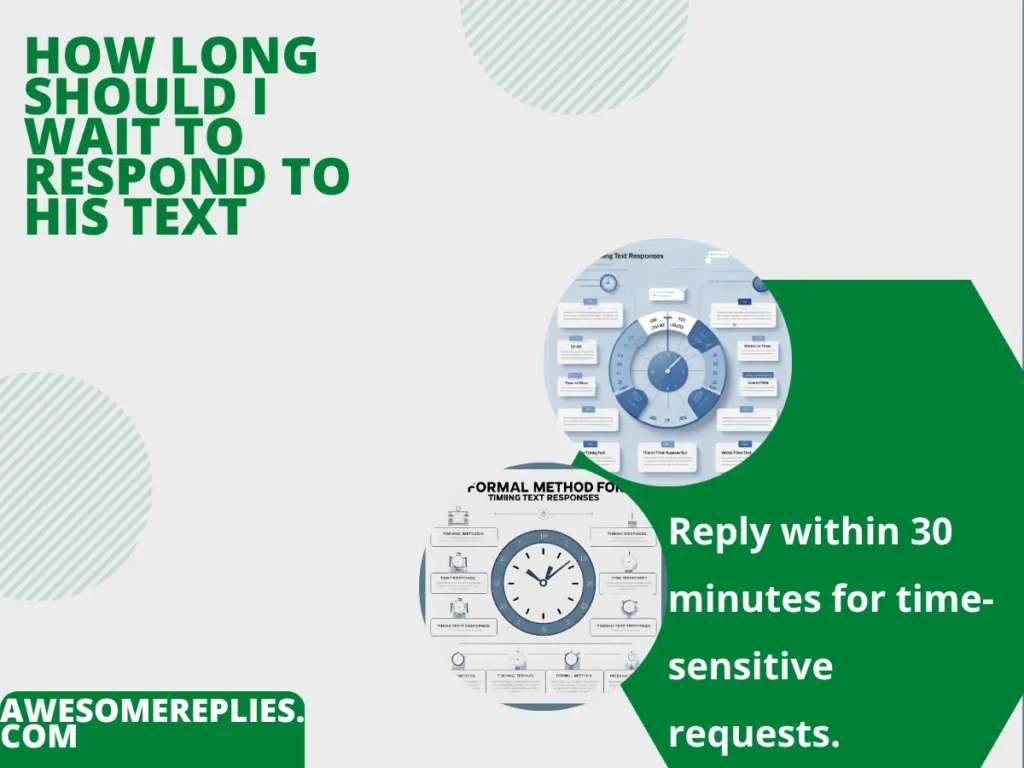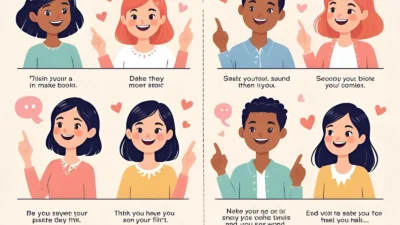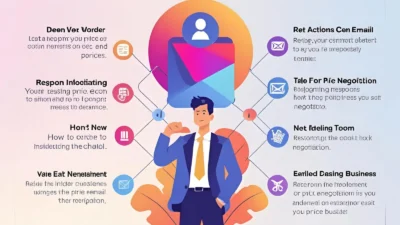Struggling to figure out the perfect timing for replying to his text? You’re not alone.
Many wonder how to balance eagerness and restraint to keep the conversation flowing naturally.
This article solves your dilemma. You’ll discover clear strategies for timing your responses based on different situations, ensuring you strike the right tone every time.
Whether it’s a casual chat, a professional exchange, or a romantic spark, the way you time your reply matters.
Read on to master the art of texting with confidence.
Different situations call for unique approaches to timing your text responses.
A quick reply to a friend might feel natural, but waiting a bit longer in a new romance can build anticipation.
In professional settings, promptness shows respect, while in casual chats, a relaxed pace keeps things light.
Below, you’ll find tailored strategies for formal, informal, idiomatic, and professional contexts to guide your texting decisions.
Formal Ways to Time Your Text Response

When texting in formal situations, timing shows respect and thoughtfulness. Delaying too long can seem dismissive, while replying too quickly might feel overly eager. Here are strategies to time your response formally:
- Respond within 1-2 hours to show attentiveness without urgency.
- Wait 2-3 hours for non-urgent messages to convey thoughtfulness.
- Reply within 30 minutes for time-sensitive requests.
- Allow 4-6 hours for less critical messages to reflect careful consideration.
- Answer within 24 hours to maintain professionalism without seeming distant.
- Delay 1-2 hours for formal introductions to avoid appearing too eager.
- Respond within an hour for follow-up texts to keep the conversation active.
- Wait 3-4 hours for messages requiring detailed thought or research.
- Reply by end of day for formal group chats to stay engaged.
- Allow 2 hours for polite acknowledgment of formal invitations.
- Respond within 45 minutes for urgent formal queries.
- Wait 1-3 hours for messages from superiors to show respect.
- Answer within 12 hours for formal apologies to convey sincerity.
- Delay 2-4 hours for messages needing careful wording.
- Reply within 1 hour for formal confirmations to show reliability.
- Wait 4-5 hours for non-pressing formal updates to maintain balance.
- Respond within 30-60 minutes for formal scheduling texts.
- Allow 3-6 hours for formal feedback requests to seem thoughtful.
- Reply by next morning for evening formal texts to show diligence.
- Wait 1-2 hours for formal thank-you messages to express gratitude.
- Respond within 2 hours for formal clarifications to avoid confusion.
- Delay 2-3 hours for formal suggestions to appear considered.
- Answer within 1 hour for formal event RSVPs to confirm promptly.
- Wait 5-6 hours for low-priority formal texts to prioritize tasks.
- Reply within 24 hours for formal networking messages to stay professional.
- Allow 1-3 hours for formal follow-ups to maintain momentum.
- Respond within 45 minutes for formal urgent updates.
- Wait 2-4 hours for formal opinion requests to reflect thought.
- Reply within 1 hour for formal deadline confirmations.
- Delay 3-5 hours for formal non-urgent inquiries to show balance.
- Answer by end of business day for formal work-related texts.
- Wait 1-2 hours for formal appreciation texts to convey sincerity.
- Respond within 30 minutes for formal crisis-related messages.
Informal Ways to Time Your Text Response
In casual texting, timing sets the vibe. Replying too fast can seem desperate, but waiting too long might feel cold. Here are relaxed ways to time your replies in everyday chats:
- Reply in 5-10 minutes to keep the conversation lively.
- Wait 10-20 minutes for a chill, laid-back vibe.
- Respond in 1-2 minutes for exciting group chats.
- Delay 20-30 minutes to avoid seeming too eager.
- Answer in 15 minutes for fun, playful banter.
- Wait 30-60 minutes for non-urgent casual chats.
- Reply in 5 minutes for quick check-ins with friends.
- Delay 1-2 hours for low-key updates to stay relaxed.
- Respond in 10-15 minutes for casual invites to seem interested.
- Wait 20-40 minutes for random memes to keep it light.
- Reply in 2-5 minutes for funny group texts to stay in the loop.
- Delay 1 hour for casual catch-up texts to seem busy.
- Answer in 10 minutes for friendly gossip to keep it flowing.
- Wait 30 minutes for casual questions to seem carefree.
- Reply in 5-10 minutes for weekend plan texts to show excitement.
- Delay 1-3 hours for non-pressing casual texts to stay cool.
- Respond in 15-20 minutes for casual apologies to sound genuine.
- Wait 40-60 minutes for random thoughts to keep it casual.
- Reply in 5 minutes for close friend check-ins to show care.
- Delay 1-2 hours for casual follow-ups to avoid clinginess.
- Answer in 10-15 minutes for casual thank-yous to seem warm.
- Wait 20-30 minutes for casual suggestions to stay relaxed.
- Reply in 2-5 minutes for urgent friend requests to show support.
- Delay 1 hour for casual opinion texts to seem thoughtful.
- Respond in 10 minutes for casual event invites to stay engaged.
- Wait 30-45 minutes for light-hearted updates to keep it breezy.
- Reply in 5-10 minutes for casual compliments to show appreciation.
- Delay 1-2 hours for low-priority casual chats to maintain balance.
- Answer in 15 minutes for casual group plans to stay involved.
- Wait 20-40 minutes for casual jokes to keep the mood light.
- Reply in 5 minutes for close friend rants to show empathy.
- Delay 1 hour for casual storytelling texts to seem relaxed.
- Respond in 10-20 minutes for casual check-ins to stay connected.
Idiomatic Ways to Time Your Text Response
Idiomatic expressions add flair to how you approach texting timing. These colorful phrases capture the spirit of strategic pauses or quick replies in unique ways:
- Strike while the iron’s hot: Reply in 1-2 minutes for hot topics.
- Play it cool: Wait 20-30 minutes to seem unbothered.
- Keep the ball rolling: Respond in 5-10 minutes for lively chats.
- Let it simmer: Delay 1-2 hours for thoughtful replies.
- Jump on it: Answer in 2-5 minutes for urgent texts.
- Hold your horses: Wait 30-60 minutes to avoid seeming desperate.
- Stay in the loop: Reply in 10-15 minutes for group chats.
- Take it slow: Delay 1-3 hours for casual, low-stakes texts.
- Seize the moment: Respond in 5 minutes for exciting updates.
- Chill out: Wait 20-40 minutes for relaxed vibes.
- Keep it moving: Reply in 10 minutes for ongoing banter.
- Let it breathe: Delay 1-2 hours for non-urgent messages.
- Be on the ball: Answer in 2-5 minutes for time-sensitive texts.
- Play hard to get: Wait 30-60 minutes for flirty texts.
- Stay on top: Respond in 10-15 minutes for active conversations.
- Give it a rest: Delay 2-3 hours for low-priority chats.
- Hit the ground running: Reply in 5 minutes for new connections.
- Take your time: Wait 1-2 hours for reflective responses.
- Keep up the pace: Answer in 10-20 minutes for fast chats.
- Let it slide: Delay 1-3 hours for casual follow-ups.
- Be quick on the draw: Reply in 2-5 minutes for urgent queries.
- Cool your jets: Wait 20-30 minutes to stay relaxed.
- Stay in the game: Respond in 10-15 minutes for group plans.
- Take a breather: Delay 1-2 hours for non-pressing texts.
- Jump in feet first: Reply in 5 minutes for exciting invites.
- Ease into it: Wait 30-60 minutes for new contacts.
- Keep the fire burning: Answer in 10 minutes for heated chats.
- Let it marinate: Delay 1-3 hours for thoughtful replies.
- Be on your toes: Reply in 2-5 minutes for critical updates.
- Take it easy: Wait 20-40 minutes for casual exchanges.
- Stay in the mix: Respond in 10-15 minutes for active threads.
- Give it a minute: Delay 1-2 hours for low-key texts.
- Dive right in: Reply in 5 minutes for close friend chats.
Professional Ways to Time Your Text Response
In workplace texting, timing reflects competence and respect. Prompt replies show efficiency, while slight delays signal thoughtfulness. Here are professional strategies for timing your texts:
- Reply within 30 minutes for urgent work requests to show reliability.
- Wait 1-2 hours for non-urgent updates to seem organized.
- Respond within 1 hour for meeting confirmations to stay on track.
- Delay 2-3 hours for thoughtful feedback to show care.
- Answer by end of day for daily check-ins to maintain professionalism.
- Wait 1-2 hours for project updates to reflect focus.
- Reply within 45 minutes for scheduling texts to stay efficient.
- Delay 3-4 hours for non-critical suggestions to seem considered.
- Respond within 1 hour for team chat updates to stay engaged.
- Wait 2-3 hours for opinion requests to show reflection.
- Reply within 30 minutes for deadline confirmations to show urgency.
- Delay 1-3 hours for non-urgent inquiries to prioritize tasks.
- Answer within 1 hour for client follow-ups to build trust.
- Wait 2-4 hours for internal feedback to seem thorough.
- Reply by next morning for evening work texts to show diligence.
- Delay 1-2 hours for thank-you messages to convey sincerity.
- Respond within 45 minutes for urgent clarifications to avoid delays.
- Wait 2-3 hours for non-pressing work chats to stay balanced.
- Reply within 1 hour for task assignments to show readiness.
- Delay 3-5 hours for low-priority updates to manage time.
- Answer within 30 minutes for crisis-related work texts.
- Wait 1-2 hours for professional introductions to seem polite.
- Reply within 1 hour for meeting follow-ups to maintain momentum.
- Delay 2-4 hours for non-urgent proposals to reflect thought.
- Respond within 45 minutes for urgent team updates to stay aligned.
- Wait 1-3 hours for networking texts to seem professional.
- Reply within 1 hour for client queries to show attentiveness.
- Delay 2-3 hours for internal suggestions to appear considered.
- Answer by end of business day for work-related group texts.
- Wait 1-2 hours for appreciation texts to convey gratitude.
- Reply within 30 minutes for time-sensitive work requests.
- Delay 3-4 hours for low-priority work chats to focus on tasks.
- Respond within 1 hour for professional RSVPs to confirm promptly.
Conclusion
Timing your text response is an art that shapes how others perceive you.
Whether it’s a formal exchange, a casual chat, or a professional message, the right pause or prompt reply sets the tone.
Use these strategies to match the situation, from quick replies that show enthusiasm to thoughtful delays that convey care.
Practice these approaches to build stronger connections and communicate with confidence.
Start experimenting today to find what works best for you.



